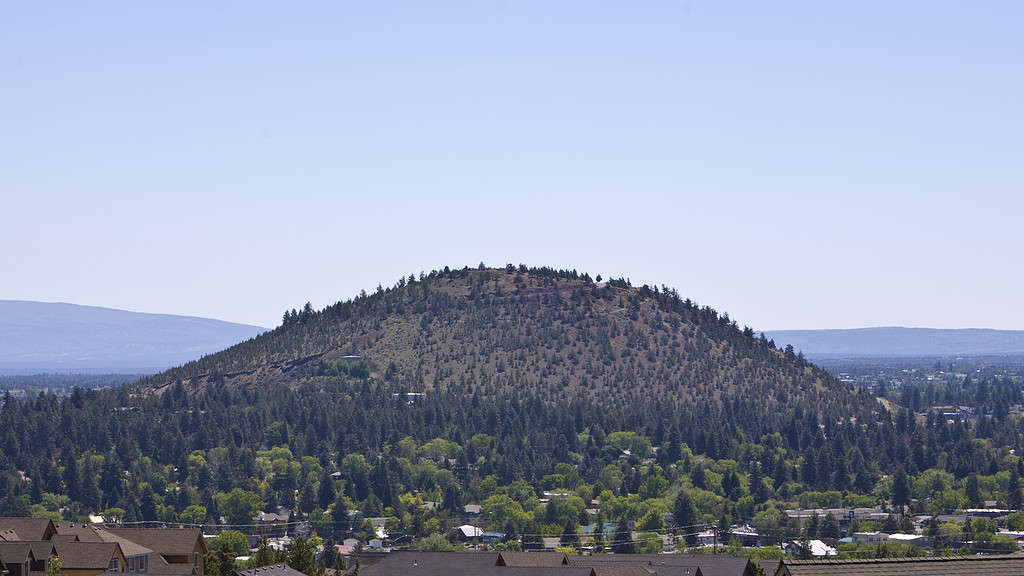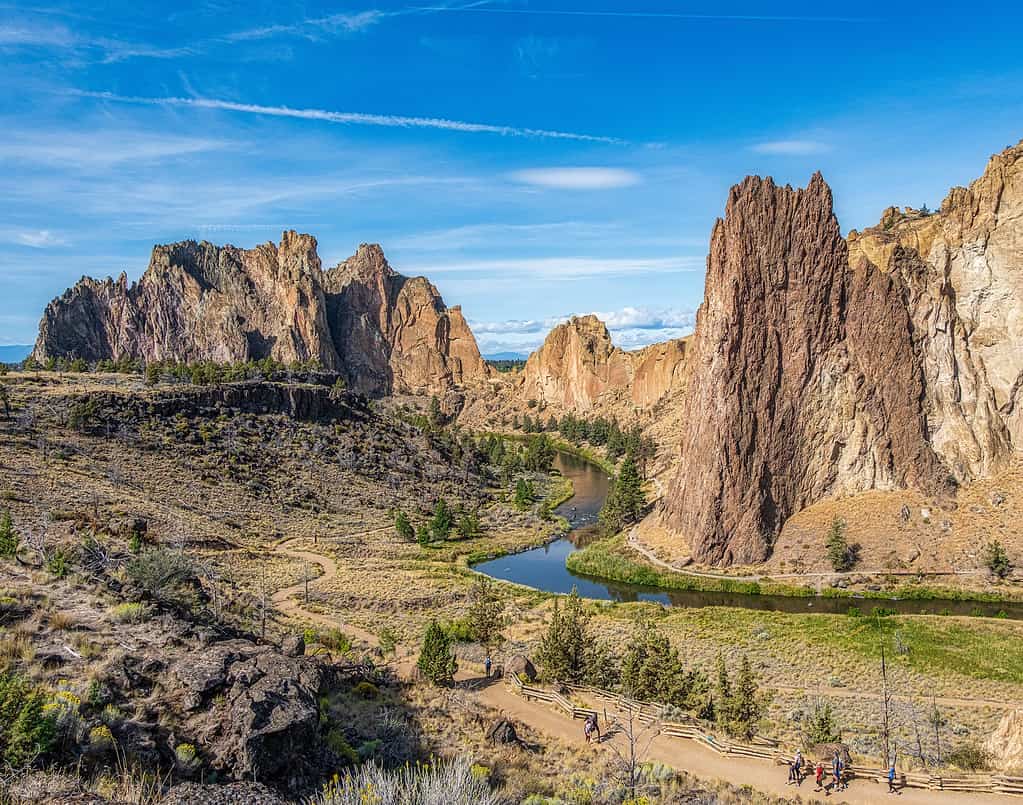The Three Sisters tower above Central Oregon as snow-capped gems of the volcanic Cascade mountain range. Each of the three peaks stands more than 10,000 feet tall and has long been a focal point of the area’s culture. In fact, the town of Sisters got its name due to its proximity to the peaks. The statuesque Sisters are visible from numerous spots throughout Central Oregon on a clear day, but some are better than others. Let’s take a look at the six best viewpoints of this breathtaking landmark, as well as some fun facts and a dive into the area’s animals.
The Three Sisters

The beauty of the Three Sisters, as well as nearby Broken Top, can be seen throughout Central Oregon.
©Structured Vision/Shutterstock.com
Aptly named, the Three Sisters consist of three peaks clustered closely together. They rank as the third, fourth, and fifth highest peaks in Oregon, falling just slightly short of Mount Hood and Mount Jefferson. The Three Sisters dominate the horizon of Central Oregon and, within the surrounding Three Sisters Wilderness, incorporate more than 260 miles of hiking trails, countless lakes, and 16 named glaciers protected by their peaks.
The Three Sisters were formed as part of the Pacific Ring of Fire, which is responsible for the many volcanoes that form the Cascade Range. Scientists believe that the North and Middle Sisters are now extinct but still actively monitor the South Sister for volcanic activity, just in case.
Fun Facts About the Three Sisters
- Settlers originally named the North, Middle, and South peaks Faith, Hope, and Charity, respectively
- South Sister is the tallest at 10,358 feet, followed by North Sister at 10,085 feet and Middle Sister at 10,046 feet
- The Three Sisters Wilderness encompasses 286 thousand acres
- The Three Sisters Wilderness is just a small part of the Deschutes National Forest, which covers over 1.6 million acres
- Because of the volcanic nature of the Three Sisters, natural hot springs are abundant throughout Central Oregon and the entire Cascade Range
Best Places to View the Three Sisters
Though the towering peaks of the Three Sisters can be seen in the distance no matter where you are in Central Oregon, these are some of the best views of the spires in the area.
Pilot Butte State Scenic Viewpoint

Pilot Butte State Park offers a great view of the Three Sisters from the heart of Bend, OR.
©Cacophony / CC BY-SA 3.0 – License
As the crow flies, the Three Sisters sit about 23 miles due west from Bend. One of the best viewpoints is, of course, in Bend. At the top of an extinct volcano, Pilot Butte offers awesome panoramic views of Bend and the surrounding landscape right from the heart of the city. Fun fact, Bend is one of just six cities in the U.S. with a volcano within its limits!
Pilot Butte requires little-to-no hiking if you don’t want to — between mid-April and November, you can drive right to the top of the butte for easy access to the breathtaking views. For those interested in a short and sweet hike, you’re in luck too! From the east parking lot at the foot of the butte, you’ll have year-round access to the summit trail. Just 500 feet of elevation gain and a well-maintained trail separate you from the top of Pilot Butte. You can also choose to walk up the paved road for an even easier ascent. Visit at sunset for particularly spectacular views of the Three Sisters, as well as Mt. Hood, Mt. Jefferson, Broken Top, and Black Butte to the west.
Three Sisters Viewpoint
This viewpoint involves traveling along Highway 20 between Bend and Sisters and pulling off about halfway. The Three Sisters Viewpoint offers designated viewpoint parking and an informational sign about the mountains on both sides of the highway. From both sides, visitors can see the Three Sisters and Broken Top to the southwest, as well as Mt. Jefferson to the northwest. Though seemingly in the middle of nowhere amongst barren fields, this viewpoint is a favorite, particularly for that reason! The striking landscape contrast between flat brushland and the majestic mountains offers a unique visual experience.
Smith Rock State Park

Smith Rock State Park features unique rock formations, while its hiking trails offer views of the surrounding mountains.
©Wirestock/ via Getty Images
This is a two-bird, one-stone stop on our tour! Smith Rock State Park offers dazzling views in and of itself, boasting deep river canyon walls that loom over the surrounding scenery. Rock climbers flock to Smith Rock’s several thousand climbs, while hikers enjoy the 12 official trails (and many more unofficial). Many of these climbs and hikes range in difficulty from beginner to expert, so take your pick and head to higher ground.
From most places in the state park, you’ll find stunning views of Smith Rock and the area’s surrounding mountains, including the Three Sisters. One hike, in particular, passes the Wombat rock formation and onto Bureau of Land Management (BLM) land for an awesome view of Smith Rock and the Three Sisters in the background.
Whychus Creek Scenic Overlook
Located just outside Sisters, OR, the Whychus Creek Overlook provides another great place to take in the majesty of the Three Sisters. This well-maintained spot sits atop some cliffs that overlook Whychus Creek as well as the rest of Central Oregon.
There are two options to reach the overlook. The out-and-back South Trail winds through the forest for about a mile before reaching the overlook. Meanwhile, the North Trail leads around the cliff and turns the overlook into a loop rather than out-and-back. Though the North Trail includes hill climbs and a longer distance, it also features two other beautiful viewpoints before reaching the overlook. The North Trail is one-way only, so all guests must return to the trailhead via the South Trail.
Tumalo Mountain Trail
Sitting just outside the Three Sisters Wilderness to the southwest of Bend, Tumalo Mountain rises almost 8,000 feet and provides spectacular views from its summit. The Tumalo Mountain Trail ranks its difficulty as moderate as it gains 1,350 feet in just two miles, so your calves might be sore by the end! However, this four-mile out-and-back trail is a favorite of visitors and locals alike for its well-maintained path, beautiful views, and abundance of flora and fauna to enjoy.
Open year-round, the Tumalo Mountain Trail boasts wildflower explosions in the summer and fantastic snowshoeing in the winter. And, of course, the amazing views of the Three Sisters. Hikers will also see Broken Top and Mt. Bachelor from the summit.
Broken Top Crater

Broken Top Crater sits very close to South Sister — a hike up the crater’s crest provides fantastic views of the Three Sisters.
©inkknife_2000 / CC BY-SA 2.0 – License
For the more adventurous, Broken Top Crater provides an up-close view of the Three Sisters. Broken Top is the fourth-tallest point in the Three Sisters Wilderness and sits about five miles southeast of the peak of South Sister. This strenuous hike up another extinct volcano ranges from eight to 14 miles round-trip, depending on whether you start from Crater Ditch Trailhead or Todd Lake. (You need a 4WD vehicle to reach Crater Ditch Trailhead.) The trail peaks at 8,200 feet, so pack your warm clothes and a headlamp in case you’re hiking back in the dark. On your way up, you’ll pass ponderosa pines, wildflowers, streams, crystal-clear glacial lakes, and more en route to the peak.
Due to its elevation, Broken Top Crater is only accessible for a few months in the summer. Those determined enough to reach the top will be rewarded with stunning views of not just the Three Sisters but also Mt. Washington, Three Fingered Jack, Mt. Jefferson, and Black Butte.
Animals of the Three Sisters

Many animals live on and around the Three Sisters, including Douglas’ squirrels.
©Randy Bjorklund/Shutterstock.com
The majority of Central Oregon ranges between forest and high desert landscapes, with all the wildlife that calls those areas home. If you venture onto some of the hiking trails in the area, you might come across any number of small or medium creatures. Frogs, like the Northern Pacific tree frog, and salamanders live near water, while a number of different snakes might slither across the trail. Watch out for rattlesnakes; they are more relaxed here, but a bite still means bad news. Many different birds — ranging from songbirds and waterfowl to birds of prey in all sizes — take advantage of the abundance of trees. The area’s bats prefer roosting near water sources and urban areas that attract their preferred insects.
Up in the forests and rocky areas, small animals like squirrels, American pika, weasels, raccoons, and yellow-bellied marmots live and play. Rainbow trout populate the area’s rivers. Mule deer can be seen from a distance, as well as elk if you’re lucky. Red foxes, bobcats, beavers, and badgers have been seen in the area, as have coyotes, cougars, gray wolves, and — occasionally — black bears.
How to Get to the Three Sisters
All roads lead to the Sisters! Alright, not all roads, but there are many ways to get to the three peaks. All of the viewpoints and hikes mentioned above sit on the other side of the Cascades from the I-5 corridor. Whether you’re traveling north or south, I-5 offers a direct path to Albany. From there, turn east on Highway 20 to traverse the Cascades. Traveling this way will bring you first to Sisters, then on to Bend. Another north-south route is Highway 97, which will bring you to Bend.
For a more scenic route for those traveling from Portland, Highway 26 takes you around the seat of Mt. Hood and offers great views while you drive. Also, this route puts the area’s different types of wilderness on display. While driving, you’ll pass through dense forest, high desert brushland, and everything in between. From the flat roads of Central Oregon, you can take in the many different peaks as you pass by en route to the Three Sisters.
The photo featured at the top of this post is © U.S. Forest Service- Pacific Northwest Region / Public domain – License / Original
Thank you for reading! Have some feedback for us? Contact the AZ Animals editorial team.






